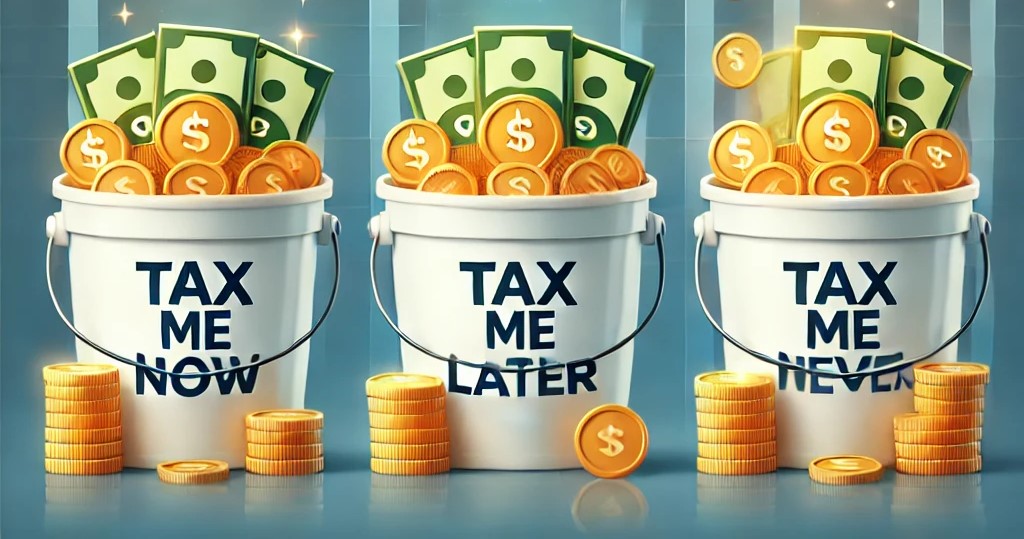Taxes play a significant role in wealth accumulation and retirement planning. One of the best ways to optimize your savings and pay as little tax as legally possible is by understanding the three tax buckets. The way your money is taxed can determine how much you keep and how efficiently your savings grow over time.
This guide will break down the three tax buckets: Tax Me Now, Tax Me Later, and Tax Me Never. By understanding the pros and cons of each, you can strategically allocate your assets to maximize tax efficiency and long-term financial security.
Bucket 1: Tax Me Now
The first of the three tax buckets includes assets that are taxed as they generate income. These include:
- Savings Accounts
- Money Market Accounts
- Certificates of Deposit (CDs)
- Brokerage Accounts (Stocks, Bonds, and Mutual Funds)
- Real Estate Investments (Despite having tax incentives, rental income and capital gains can be taxed)
Pros of Taxable Accounts
- Liquidity: These accounts typically allow unrestricted access to funds without penalties.
- No Contribution Limits: Unlike tax-advantaged accounts, there are no contribution restrictions.
- Capital Gains Benefits: Long-term capital gains (for assets held over a year) are taxed at lower rates than ordinary income.
- Safety: Many offer a safe consistent return with no risk of losing money, except for brokerage accounts and real estate.
Cons of Taxable Accounts
- Annual Taxation: Interest, dividends, and realized capital gains are subject to annual taxation, reducing net returns.
- Higher Tax Brackets in Retirement: If you accumulate substantial assets in this bucket, you may face unnecessary tax drag over time.
- Opportunity Cost: By putting money in savings or CDs, you could be missing out on higher returns offered by other investments.
Real Estate: A Special Case
While real estate falls under “Tax Me Now,” it offers unique tax benefits that make it attractive:
- Depreciation Deduction: Investors can deduct depreciation from rental properties to reduce taxable income.
- 1031 Exchanges: Allows investors to defer capital gains taxes by reinvesting in another property.
- Mortgage Interest Deduction: Homeowners can deduct mortgage interest, reducing taxable income.
- Capital Gains Exclusion: Up to $250,000 ($500,000 for married couples) of capital gains on the sale of a primary residence may be tax-free if lived in for two of the last five years.
Despite these advantages, real estate still generates taxable income, and investors should be aware of potential liabilities.
Bucket 2: Tax Me Later
Of the three tax buckets, Tax-deferred accounts are probably the most familiar. They allow investments to grow tax-free until withdrawal. These include:
- 401(k) and 403(b) Plans
- Traditional IRAs
- SEP IRAs (Self-Employed Plans)
- SIMPLE IRAs
- Deferred Annuities
Pros of Tax-Deferred Accounts
- Immediate Tax Benefits: Contributions reduce taxable income, lowering your current tax bill.
- Tax-Free Growth: Investments compound without annual taxation, maximizing potential returns.
- Employer Contributions: Many employers offer matching contributions to 401(k) plans, effectively giving you free money.
Cons of Tax-Deferred Accounts
- Higher Future Tax Rates: Withdrawals are taxed as ordinary income. If tax rates increase, you could pay more in retirement.
- Required Minimum Distributions (RMDs): Beginning at age 73 (as of 2023), retirees must take RMDs, which can push them into higher tax brackets.
- Early Withdrawal Penalties: Funds withdrawn before age 59½ incur a 10% penalty (with some exceptions).
- Limits Flexibility: If you have an unexpected purchase or investment opportunity arise, you may not be able to fund the purchase without incurring significant tax burdens. It may move you to a higher tax bracket.
Inflation and Future Tax Risks
While deferring taxes may seem beneficial now, consider that:
- Future tax rates could be higher due to government debt and spending.
- Inflation reduces purchasing power, meaning your tax-deferred withdrawals may buy less in the future.
- Your required distributions could push you into a higher tax bracket than expected.
Given these risks, tax-deferred accounts should be part of a diversified strategy, not the sole component of retirement planning. Beware of putting all your retirement savings solely in tax deferred accounts.
Bucket 3: Tax Me Never
The third and most powerful of the three tax bucket consists of accounts that allow for tax-free growth and tax-free withdrawals:
Roth IRAs: The Basics
A Roth IRA allows after-tax contributions, meaning you do not get an upfront tax deduction, but your money grows tax-free, and withdrawals in retirement are tax-free.
Key Benefits:
- Tax-Free Withdrawals: If you meet age (59½) and holding period (5 years) requirements, you pay no tax on withdrawals.
- No RMDs: Unlike traditional IRAs, Roth IRAs do not require mandatory withdrawals, allowing your money to grow longer.
- Lower Future Tax Burden: Ideal for those expecting higher tax rates in retirement.
Limitations:
- Income Limits: Single filers earning over $153,000 and married filers over $228,000 (2023) cannot contribute directly.
- Contribution Limits: Limited to $6,500 per year ($7,500 if age 50+ in 2023), which may not be enough for high earners.
- Market Risk: While you have the potential for greater returns, you also have the potential to lose money.
Cash Value Life Insurance: A More Flexible Alternative
Cash Value Life Insurance (CVLI), particularly Indexed Universal Life (IUL) and Whole Life Insurance, offers a powerful, flexible solution for those looking to minimize taxes and maximize financial security.
Key Benefits:
- Practically Unlimited Contributions: Unlike Roth IRAs, there are no strict contribution limits.
- No Income Restrictions: High earners can use CVLI without limitations.
- Tax-Free Withdrawals via Policy Loans: Unlike taxable withdrawals from a 401(k), policy loans are not considered income and are tax-free if managed correctly.
- Access Funds at Any Age: Unlike retirement accounts, CVLI allows withdrawals without penalties.
- Market Protection: Many policies offer floor guarantees, meaning you won’t lose money during market downturns.
- Protects My Family: In case of an catastrophic accident or terminal illness, my family won’t have to bear any financial burden.
- Multi-Purpose Use: Can be used for college savings, business financing, retirement planning, buy-sell agreements, business exit planning, and advanced strategies to reduce current and future taxes.
Downsides:
- Long Term Strategy: Requires consistent funding to build cash value effectively.
- Moderate Returns: Growth is conservative compared to stocks, but the safety and tax advantages compensate.
- Requires Proper Structuring: Not all life insurance policies are designed for tax-efficient growth, so working with a knowledgeable advisor is crucial.
Why I Use Both a Roth IRA and Cash Value Life Insurance
I personally use both a Roth IRA and a properly structured cash value life insurance policy because:
- Diversification: I want both market exposure (Roth IRA) and protected growth (CVLI).
- No Market Risk in CVLI: Unlike the stock market, my cash value is protected from volatility.
- Higher Contribution Limits: CVLI allows me to save far beyond the Roth IRA limits.
- Flexible Access: I can take loans or withdrawals from my CVLI at any time, for any reason.
- Legacy Planning: Life insurance provides a tax-free death benefit to my heirs, ensuring wealth transfer efficiency.
Strategic Use of The Three Tax Buckets for Maximum Wealth
To minimize taxes and optimize savings using the three tax buckets, consider the following approach:
- Maximize Employer 401(k) Match: If your employer offers matching contributions, contribute enough to get the full match—it’s free money.
- Start a Cash Value Life Insurance Policy: Especially if you are a high earner, a business owner, or starting retirement planning late, cash value life insurance offers unparalleled flexibility and tax advantages.
- Fund a Roth IRA: Take advantage of tax-free growth and withdrawals.
- Use a Taxable Brokerage Account Strategically: Focus on tax-efficient investments like ETFs and long-term holdings.
Final Thoughts
Understanding the three tax buckets can help you keep more of your money and build tax-free wealth for retirement and beyond. By strategically allocating assets across these buckets, you can reduce your tax burden, increase financial flexibility, and protect your wealth from market volatility and future tax hikes.
I firmly believe that most people should consider having both a Roth IRA and a Cash Value Life Insurance policy to create a well-rounded tax-free savings strategy. The key to financial success is minimizing taxes while maximizing control over your money.


2 responses to “The Three Tax Buckets: A Guide to Tax Free Savings”
[…] The Three Tax Buckets: A Guide to Tax Free Savings […]
[…] proverbial ‘tax bucket’ down the road to be paid at a later date. Check out our post on “The Three Tax Buckets” to learn […]